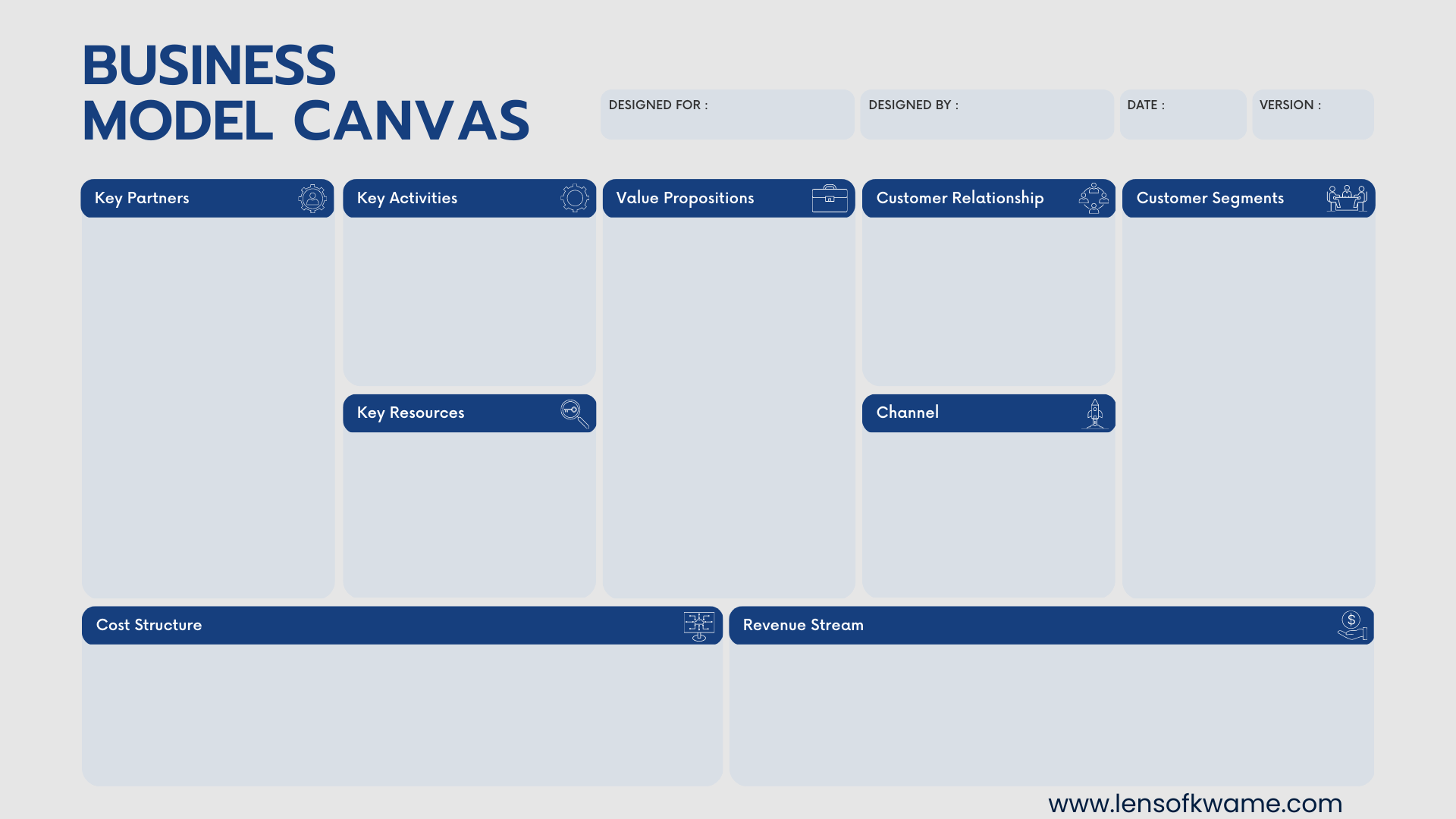Today’s episode is about consistency over perfection. The world is going through a lot now and most of us are in a boat of uncertainty waiting for the the perfect time to start something. We can’t wait forever because if we’re waiting for all the answers to start, We...
If you’re starting a new business, a business plan is essential. A business plan helps you focus your ideas, set achievable goals, and secure funding. However, creating a traditional, lengthy business plan can be overwhelming. Fortunately, there’s a more streamlined approach to business planning: the Business Model Canvas. In this blog post, we’ll discuss five steps to writing an effective business plan using a Business Model Canvas.
Step 1: Understand the Business Model Canvas

The Business Model Canvas is a one-page document that outlines the key components of your business. It’s divided into nine sections, each of which is essential to your business’s success. By understanding these sections and how they relate to your business, you can create an effective business plan. To better understand the Business Model Canvas, let’s take a closer look at each section.
Customer Segments: This section helps you define the different groups of people or organizations that your business will serve. Identifying your customer segments early on can help you tailor your products or services to their specific needs.
Value Proposition: This section helps you define the unique value that your business provides to your customers. Your value proposition should clearly communicate what sets you apart from the competition and why customers should choose your business over others.
Channels: This section defines the different ways that your business will reach your customers. This could be through direct sales, online marketing, or other channels.
Customer Relationships: This section defines how your business will build and maintain relationships with your customers. This could be through personal assistance, self-service, or other methods.
Revenue Streams: This section defines the different ways that your business will generate revenue. This could be through product sales, service fees, or other revenue streams.
Key Activities: This section defines the key activities that your business needs to perform in order to deliver your value proposition to your customers.
Key Resources: This section defines the key resources that your business needs in order to deliver your value proposition to your customers. This could be anything from physical resources such as equipment or facilities to intellectual property such as patents or trademarks.
Key Partnerships: This section defines the key partnerships that your business needs in order to deliver your value proposition to your customers. This could be anything from suppliers to strategic alliances with other businesses.
Cost Structure: This section defines the costs that your business will incur to deliver your value proposition to your customers. This could be anything from rent and salaries to marketing and advertising costs.
Step 2: Identify Your Customer Segments and Value Proposition
Your customer segments and value proposition are the foundation of your business model. You need to understand who your customers are, what their needs are, and how you can meet those needs better than your competitors. Identifying your customer segments early on can help you build a customer profile for each group, considering their needs, wants, and pain points. Your value proposition should clearly communicate your unique selling proposition and what sets you apart from the competition. When considering your customer segments, think about the different groups of people that your product or service will appeal to. These could be based on demographics such as age, gender, location, or interests. Once you have identified your customer segments, you can then start to build a customer profile for each group, considering their needs, wants, and pain points. This will help you better understand your customers and tailor your products or services to their specific needs. Your value proposition is the foundation of your marketing message. It should clearly communicate what you offer, how it solves a problem, and why it’s better than the competition. Your value proposition should be clear, concise, and easy to understand. It should be the key selling point of your business and should set you apart from the competition.
Step 3: Define Your Channels and Customer Relationships
Once you’ve identified your customer segments and value proposition, you need to determine how you’ll reach your customers and how you’ll build relationships with them. This includes defining your channels (e.g., online, brick-and-mortar) and customer relationships (e.g., personal assistance, self-service). When defining your channels, consider the different ways that you can reach your customers. This could be through online advertising, social media, trade shows, or other marketing efforts. When considering your customer relationships, think about how you want to interact with your customers. This could be through one-on-one meetings, email newsletters, or other forms of communication. It’s important to build strong relationships with your customers to ensure their loyalty to your business. By providing excellent customer service and engaging with your customers regularly, you can build a loyal customer base that will support your business for years to come.
Step 4: Determine Your Revenue Streams and Cost Structure
Your revenue streams and cost structure are critical components of your business model. You need to identify how you’ll make money and what your costs will be. This includes understanding your pricing strategy, sales projections, and expenses. When determining your revenue streams, consider the different ways that you can generate income. This could be through product sales, service fees, or advertising revenue. It’s important to have a diverse range of revenue streams to ensure the financial stability of your business. When considering your cost structure, think about the different expenses that you’ll incur when running your business. This could be rent, salaries, marketing, or other expenses. It’s important to keep your costs under control to ensure that your business is profitable.
Step 5: Test and Refine Your Business Model
Once you’ve completed the first four steps, it’s time to test your business model. This involves gathering feedback from customers, investors, and other stakeholders to refine your model and ensure its viability. You may need to make adjustments to your customer segments, value proposition, channels, revenue streams, or cost structure based on this feedback. When testing and refining your business model, consider the feedback that you receive from your customers, investors, and other stakeholders. This feedback can help you identify areas where your business model may need to be adjusted. Be open to making changes to your business model and be willing to pivot if necessary.
Conclusion
Creating a business plan is an essential step in starting a new business. By using the Business Model Canvas and following these five steps, you can create an effective business plan that sets you up for success. Building a successful business takes time and effort. It’s important to stay focused on your goals and to remain adaptable to changing circumstances. By staying up-to-date on industry trends, keeping your customers happy, and managing your finances effectively, you can build a successful business that lasts for years to come. Remember that entrepreneurship is a journey, not a destination. By staying focused and remaining adaptable, you can build a successful business that lasts for years to come. Good luck on your entrepreneurial journey!
Join the conversation.
Let us know what you think about this episode.
You may also enjoy…

The Dos and Don’ts of Building a Purpose-Driven Brand
Nowadays, consumers are increasingly aware of the impact of their purchases. Thus, building a purpose-driven brand has become more important than ever. A purpose-driven brand goes beyond selling products or services and aims to make a positive impact on society. It is...

The Importance of Branding for Small Businesses
Small businesses play a significant role in the global economy, providing goods and services to communities around the world. However, small businesses often face challenges in standing out in a crowded market and attracting customers. To overcome these challenges,...

The Importance of a Brand Audit: Why You Need to Revisit Your Strategy Regularly
When you started your business, you probably put a lot of thought and effort into creating a brand strategy that would perfectly represent your company. However, as time goes on, your business and the market around it can change, meaning your branding strategy might...




0 Comments